
Who ever would have thought you could find Africa’s most exciting trout fishing rivers here? Patrick Tillard tells us why it is.
Dreaming of a place where the trout always bite? In the wilds of Mount Kenya and the Aberdares, where elephant, buffalo and leopard roam, the pristine streams and lakes offer unparalleled angling that is as exciting and unique as it is untapped. Words and photographs by Patrick Tillard.
I tread gingerly through the bog following guide Sven Verwiel intently, my eyes and ears pricked for the slightest noise. Last night, returning to our bandas (huts) just as the last trace of dusk faded to inky darkness, we bumped into a young male leopard scurrying across the timberland track. He stopped briefly, no more than 10 metres away, his wide-eyed stare slicing through mine – awesome beauty and cruel menace in one look – before slinking silently into the undergrowth. The path we walk now to the river indicates similar danger; freshly cut by buffaloes in the night as they leave the forest to graze the open plains. Although now back in the shade of the bush, there is no doubt they are close by, as are elephants and hyenas. Close encounters with these animals, especially on foot, are best avoided.
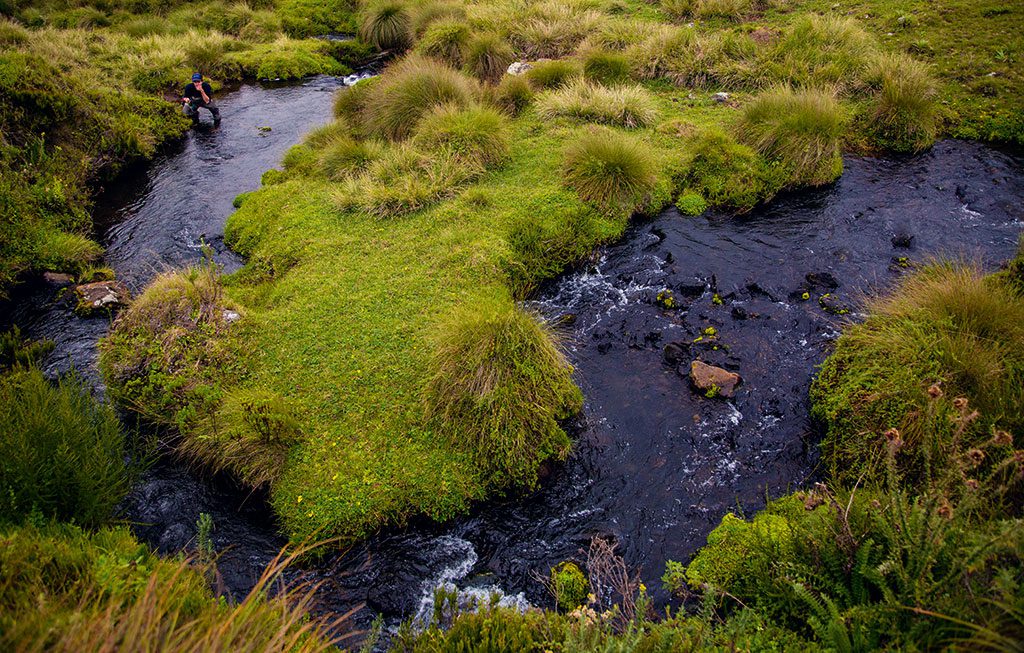
Fishing guide Sven Verwiel casts a fly into a tiny pool in Mount Kenya National Park. This stretch is typical of the intimacy that can be expected when fishing at 3000 metres. Photo by Patrick Tillard.
At the equator, the sun rises as fast and dramatically as it falls. As we reach the water, warmth is already puncturing the cold mountain air; the aroma of upland shrubs balms the soft breeze and the cover resonates with exotic birdsong. From the shrinking glaciers way above us, icy flows gather momentum through the rocks and moorlands, forging a long course towards the Indian Ocean.The upper reaches, still far from any villages that depend on these waters for survival, run narrow and crystal clear, teeming with brown trout – wild specimens descended from fish stocked by colonial settlers such as Ewart Grogan back in the 1900s, onerously transported from Loch Leven in Scotland by boat and ox-cart (a journey of some 7 000 miles).
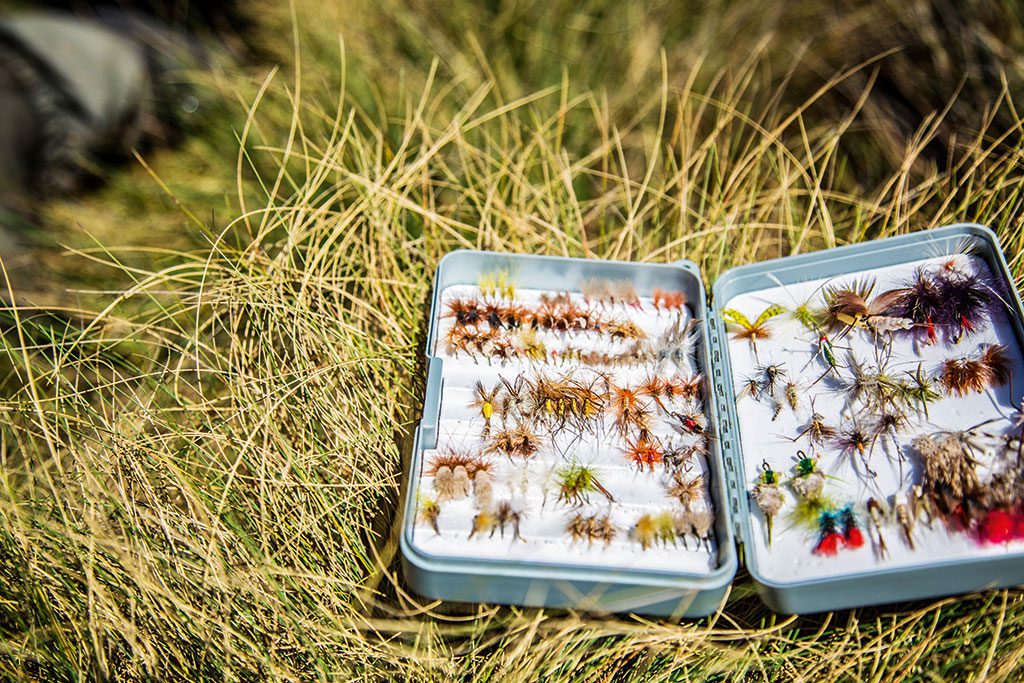
The right choice of fly is vital when chasing wily trout. Patterns must mimic what the fish are feeding on at that time. Photo by Patrick Tillard.
Sven crawls on hands and knees and spies into a pool no wider than a single step. He turns and beckons his sister Michelle into position with an excited glint in his eye. Using a bow and arrow cast, she flicks a dry fly into the bubbling current – there is a subtle art to fishing Kenya’s streams; a blend of skill and stealth – and a fish hits the imitation as if it were a starved crocodile during the wildebeest migration. It has likely never seen an angler’s lure before. The one-pound brownie charges irately up and down the small pool before succumbing to hand, a rich golden flank peppered with black and rose freckles. After careful admiration, Sven releases the trout back into the flow – as he insists all guests do – to safeguard the health of future stocks.
The intimate fishing within these elevated lands is as untapped as it is remote. Reaching the town of Chogoria a few days earlier, 185 kilometres from Nairobi, passing swathes of tea and banana plantations, rice fields and hectic stalls selling assorted fruits and kitsch wares, we turned on to a red-dirt road carving a track up the mountain. Signs of civilisation soon dried up. For 26 kilometres the car jerked over potholes the size of bathtubs and spine-juggling corrugations, through luscious upland forest bruised by elephant, and thick impenetrable bamboo opening up into wide heaths of grass tussocks browsed by reedbuck, waterbuck and eland. Here, the rudimentary bandas of Mount Kenya National Park, the acclimatising stopover for hikers and porters, sit in the shadow of
the sacred massif.
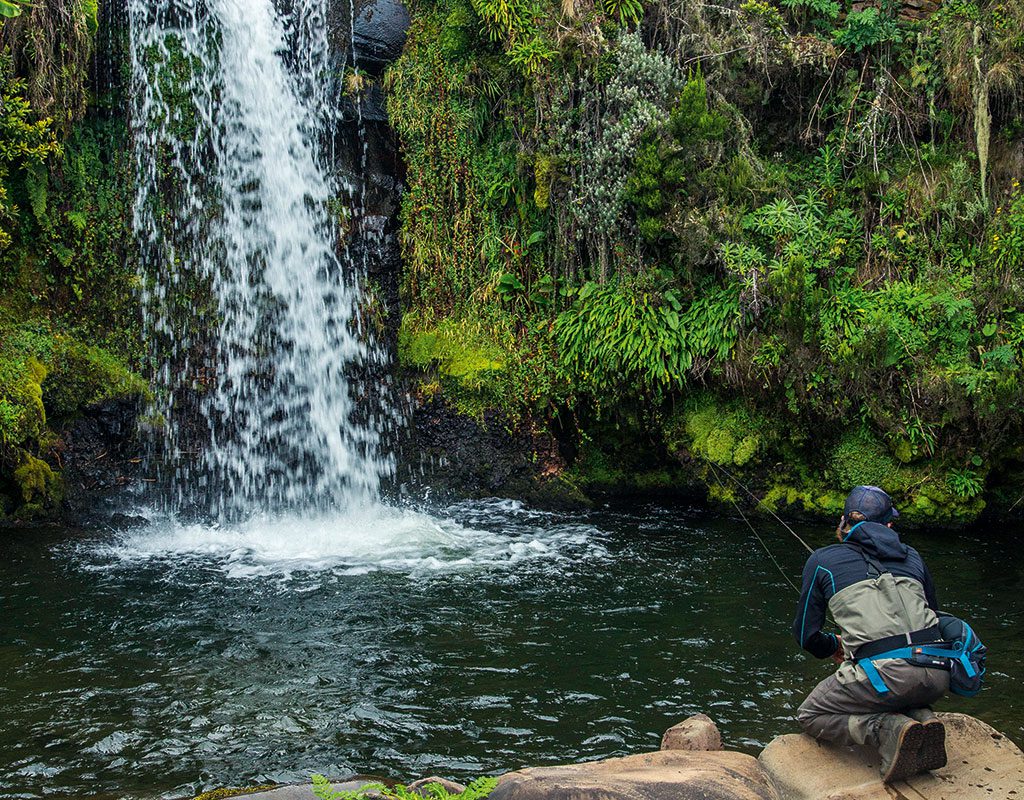
Sven searches a deep pool under one of the many waterfalls. These pools provide oxygenated pockets and rich feeding for the trout, and act as natural barriers to their movement, providing fast sport for anglers. Photo by Patrick Tillard.
From past accounts, however, our journey was relatively comfortable – it wasn’t all that long ago that the treacherous road to the camp was inaccessible to vehicles, eviscerated by the heavy annual rains. Sven learned of these rivers and similar systems in the sylvan depths of the Aberdares by studying Google Earth maps, and then, drunk on the idea of unearthing hidden gems, dedicated days and weeks to exploring them on foot with nothing but a few provisions on his back and a rod in his hand. His hunch was right. He found mile after mile of enticing pools and riffles that were totally unexploited. And, bar the occasional anglers he takes into these wild and testing hinterlands, they remain just so.
Sven is a font of knowledge on all things piscine, his depth of understanding about trout and their ecosystem encyclopaedic. His specialist company, Iolaus, offers trips to the lesser-known waters of East Africa (‘where fishing takes you to the most beautiful places on Earth’), although this is just the tip of the iceberg of his longterm vision. He aims to put Kenyan fishing on the map, and by using the trout as a badge of river health, in turn he has epic ambitions to preserve vast chunks of the country’s habitats. A legacy is budding.
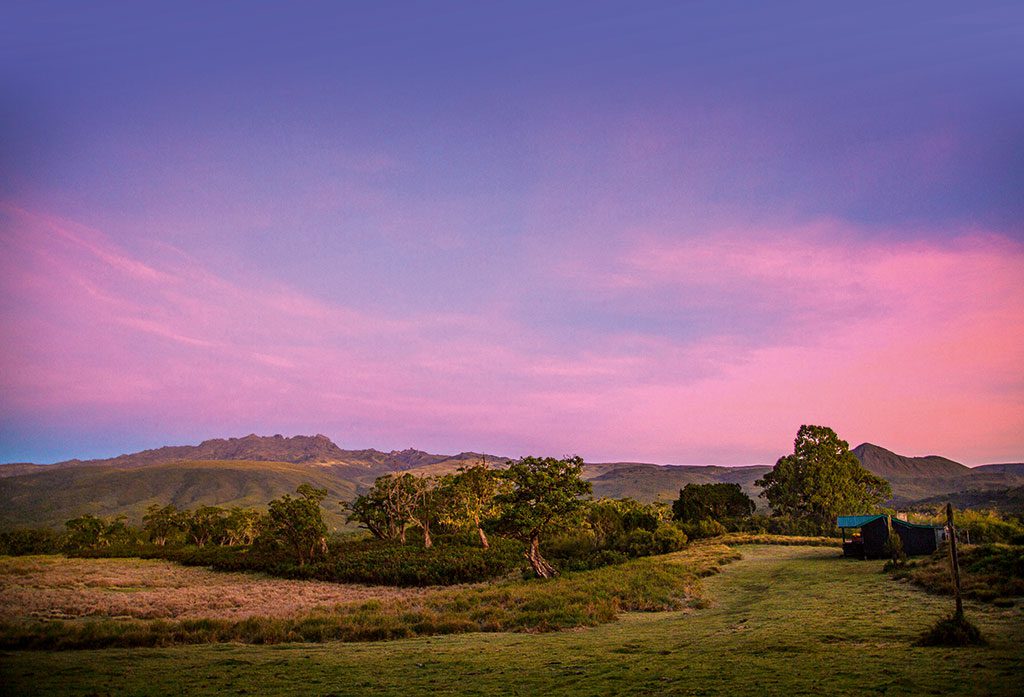
The fishing hut may be rudimentary, butit comes with a most magnificent view. From here, you can see Batian Peak, the highest point of Mount Kenya. Photo by Patrick Tillard.
The sun is high overhead as we break for lunch. The vivid red wing tips of a turaco flash through the branches of cedar draped in bearded moss, and the cry of a fish eagle echoes on the hill. The Batian peak of Mount Kenya juts into a cobalt sky, the first string of alpinists already descending from the 5 199-metre summit – Africa’s second-highest mountain – having woken well before sunrise.
Sven has something totally different planned for the afternoon. In the lakes higher up the mountain, where the air is silky thin and wildlife is scarce, stocked rainbow trout have been left to their own devices and have taken to the conditions with unprecedented zeal. In less than two years, fish grow from fingerlings to three-pound brutes, climbing well into double figures.
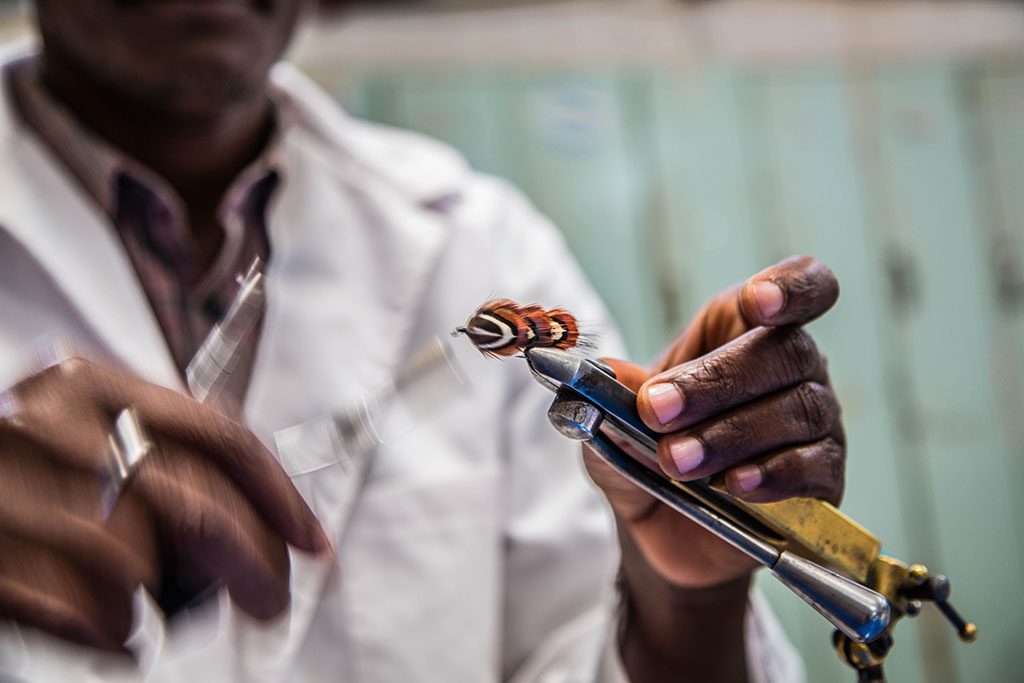
With the hook clamped in a vice, a craftsman sets about meticulously tying a fly. Photo by Patrick Tillard.
Back on hands and knees, he spots at least eight fat trout lying in the translucent shallows only a few feet from the bank, ranging from four to 12 pounds (1,8 to 5,4 kilograms). He gives a point of reference, three feet in front of the fish, and tells me to strip the line slowly, hoping to induce a follow. As expected, he’s right. A rainbow turns with intent as the fly swings past its nose, making a move at the last minute. A five-pound hen sporting vibrant pink and silver erupts through the surface. It is the first of many.
Far from civilisation, this is unlike any other fishing to be found within the pages of an atlas. It is not for the faint-hearted – the highest lake, Michaelson, sits above the clouds at an altitude of 4700 metres and commands a gruelling hike. But it is worth the effort. Mount Kenya, like so much of Africa, is an area of spectacular extremes and constant surprise.
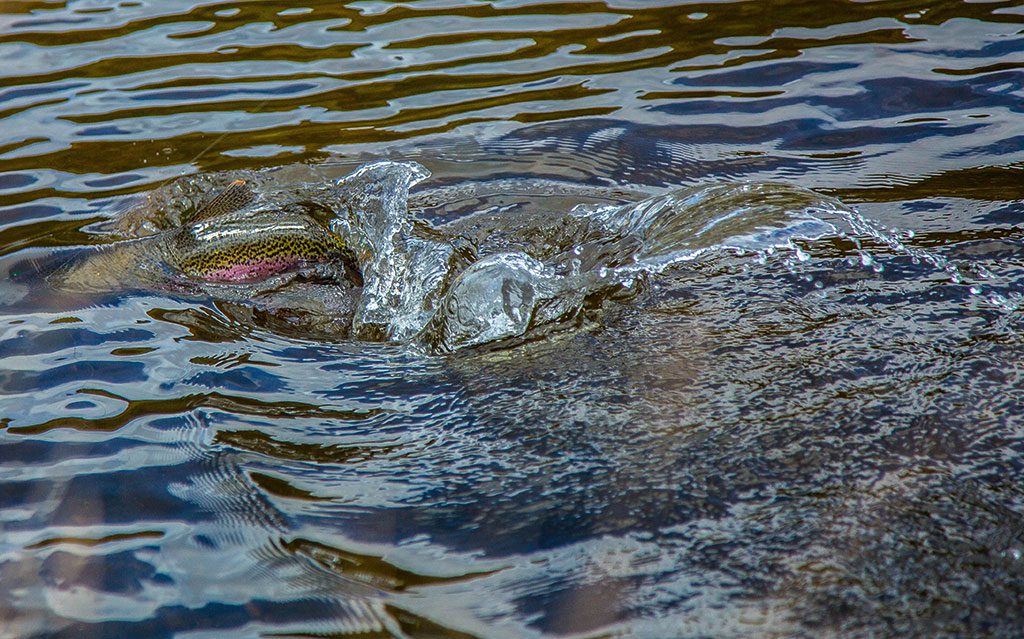
A five-pound (2,3 kilograms) rainbow trout makes a dash for freedom in Lake Ellis. Photo by Patrick Tillard.
Descending the steep crags of the mountain as a dense mist closes in, Sven has one last stop in mind before we return to the bandas to recall the day’s action over a cold lager and braai. It is a complete change once more. A slender ribbon of fast water lined by giant heather tumbles through deep gorges and over waterfalls that appear without warning, the noise masked by thick vegetation. We enjoy another hour of constant action, as small, feisty brown trout hurl themselves at our myriad nymphs and dry-fly patterns. I lose track of time, but thankfully Sven is not so easily led awry.
As the sun melts behind the ridge, a riot of colour streaking across the sky, we reluctantly peel ourselves from the river. But we must; soon the leopards and buffaloes will be leaving the bush. I don’t fancy chancing my luck for a second night running.
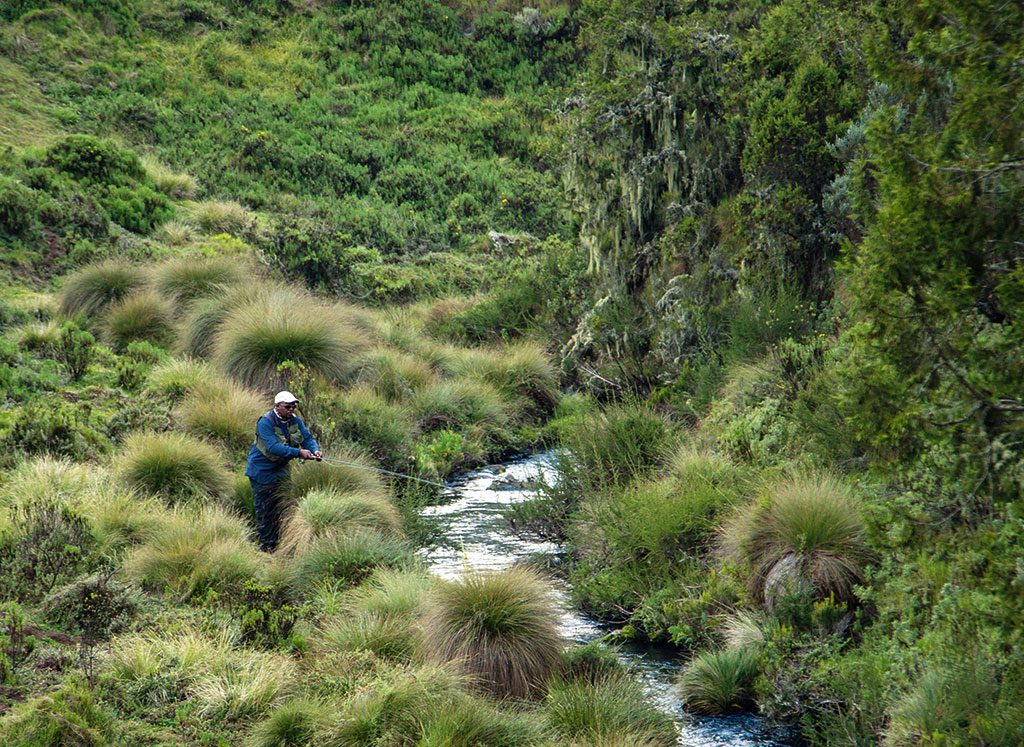
Joe Njeru keeps back from the water’s edge to avoid disturbing the trout. Even in the narrow pools that wind through the bush, fish up to three pounds (1,3 kilograms) can be caught. Photo by Patrick Tillard.
Plan your trip
Getting there
Kenya Airways flies to Nairobi daily from Joburg and three times a week from Cape Town; it costs from R7300. kenya-airways.com. A guide will meet you at the airport and drive you to the camp (two to five hours depending on which lake or river it’s at), on frenetic roads but through beautiful scenery. Flights to Nanyuki from Nairobi, which reduces time on the road significantly, can also be organised.
When to go
The fishing season is dictated by dry weather and runs from July through to early October and again from December to March. The mountain ranges have their own microclimates, with the average temperature being 20°C to 25°C. Conversely, at night it can drop below zero and frosts are common. Remember that at high altitude your skin is extremely susceptible to sunburn.
Costs
Iolaus Fishing Travel has various, customisable fishing packages on two of Kenya’s most stunning mountain ranges, the Aberdares and Mount Kenya. Rates start from about R4200 pp for a two-day trip (for four people), and R23 800 pp for six days – this includes all park fees, fishing licenses, food, accommodation and road transport within the country. iolaus.biz
Need to know
Be warned: the fishing is, in places, hard going. While the lakes are novice-friendly, the narrow streams require proficiency with a rod. The guides will ensure that you are well looked after, whatever your level of experience. It is certainly worth having a casting lesson or two beforehand. Elephant and buffalo are abundant in both Aberdare and Mount Kenya National Parks, and their presence makes for an unequalled fishing trip. Show respect and listen to the guides at all times when in the vicinity of these animals. South Africans do not need a visa to visit Kenya for less than 30 days.
Accommodation
The mountains have a combination of rustic bandas and higher-end cabins. At Chogoria, our huts were simple but comfortable. It’s the unique fishing and surroundings that are the focus on these trips. The host will ensure that the food is fresh and hearty, matching the day’s itinerary. Menus can be customised.
What to take
For the fishing: waders, 2–3 wt rods for rivers and 4–6 wt rods for lakes, tippets up to 6lb and a wide selection of flies (ideally nymphs, streamers, buzzers and dry flies). If you don’t have everything on the list, fear not – Sven has more kit than you can shake a stick at. Rental costs from R350 a day for a rod, line and reel. Other necessities: hiking boots, warm clothing for the evenings, a rain jacket, comfortable shoes, sunglasses, sun cream, a small backpack and insect repellent.
Read more from this story in the January 2017 issue of Getaway magazine.
Our January issue features a bucket list of 45 experiences to have at least once in South Africa, a new way to experience the Wild Coast, and a beautiful beach holiday in Sri Lanka.
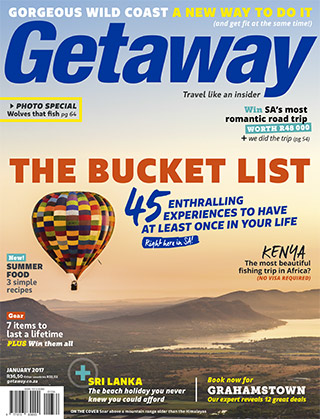
This article, Why Mount Kenya is Africa’s most exciting trout fishing spot, was originally posted on the Getaway Blog by Getaway.